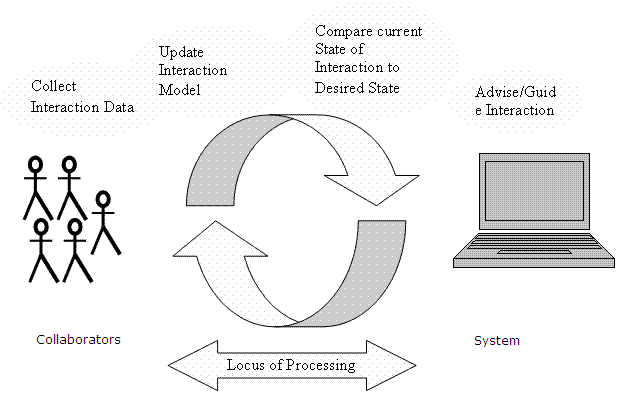Appendix 2 Collaborative Design Theory:
Over the past decade, we have seen an explosion of network-based technologies that enable traditional and non-traditional distance learners alike to learn collaboratively. These environments enhance traditional distance learning curricular/curriculum by giving students the opportunity to interact with other students and share ideas. But especially for domains in which teamwork is critical, do these environments measure up to traditional classroom group activity? Classrooms provide supportive environments.
Where teams of students learn in the presence of an instructor who helps to manage and guide the collaboration, providing clear goals as to what is expected from the group process.

Mirroring/Awareness: Meta Cognition: Advising/Moderating Tools.
Appendix Fig 1.1 Model of Computer based Collaborative Learning.
The collaboration management cycle, showing points at which the responsibility for analyzing and guiding the interaction might shift from the collaborators to the system.
The data collection phase involves observing and recording the interaction. Typically, users’ actions (e.g. ‘user1 clicked on I agree’, ‘user1 left the room’) are logged and stored for later processing.
The next phase involves selecting one or more high-level variables, termed indicators, to represent the current state of interaction. An indicator’s values may be obtained by instantiating a model of interaction with the data obtained in the first step. For example, an agreement indicator might be derived by comparing the problem-solving actions of two or more students, or a symmetry indicator might result from a comparison of participation indicators.
The interaction can be “diagnosed” by comparing the current state of interaction to an ideal model of interaction. In this paper, we define an ideal model as a set of indicators describing desirable and undesirable interaction states. For instance, we might want learners to be verbose, agree frequently, and participate equally.
Finally, if there are discrepancies between the current state of interaction (as described by the indicator values) and the desired state of interaction, some remedial actions might be proposed. Simple remedial actions (e.g. ‘You have not participated enough’) might result from analyzing a model containing only one indicator (e.g. word or action count), which can be directly computed from the data, whereas more complex remedial actions might require a more sophisticated computational model.